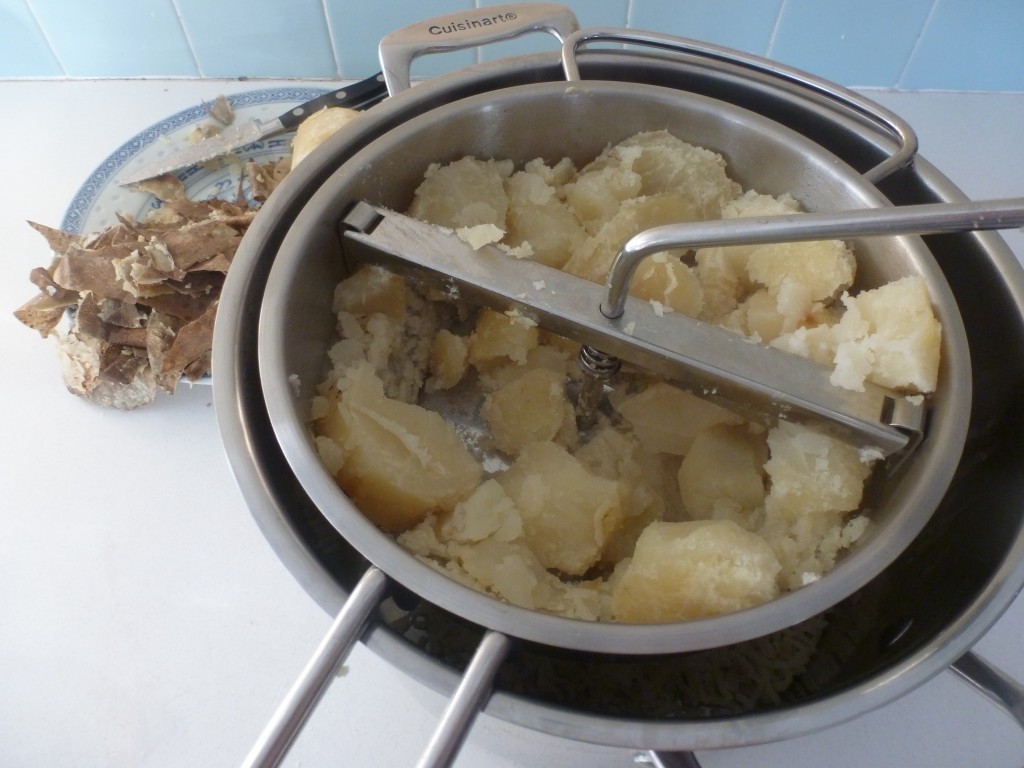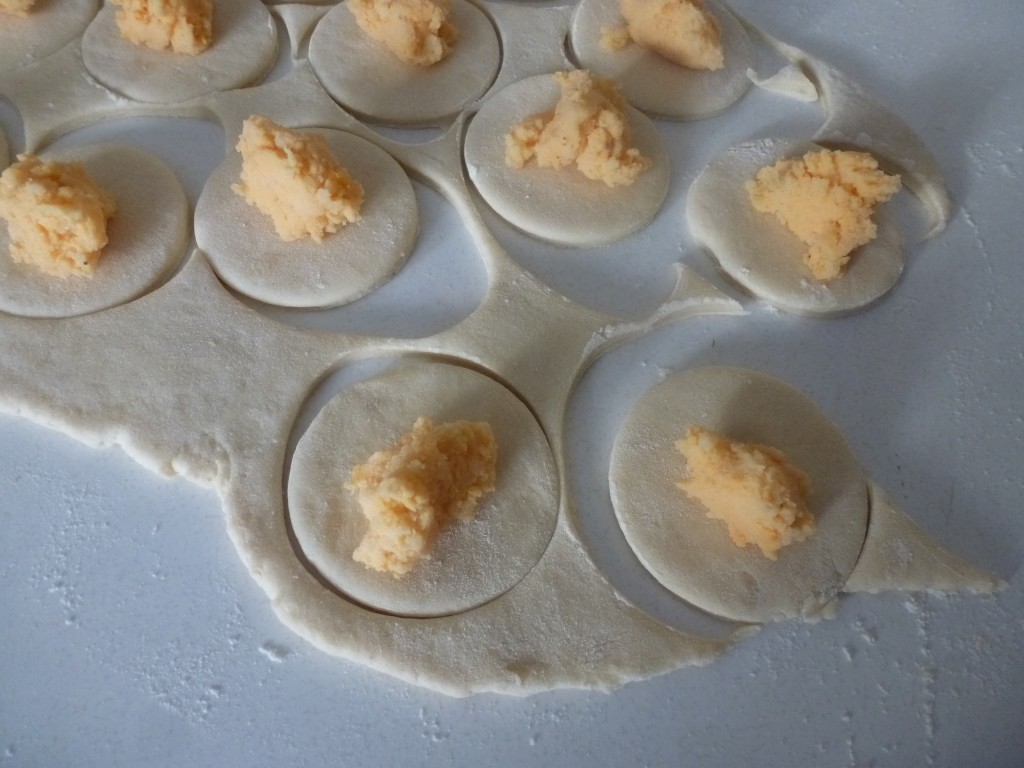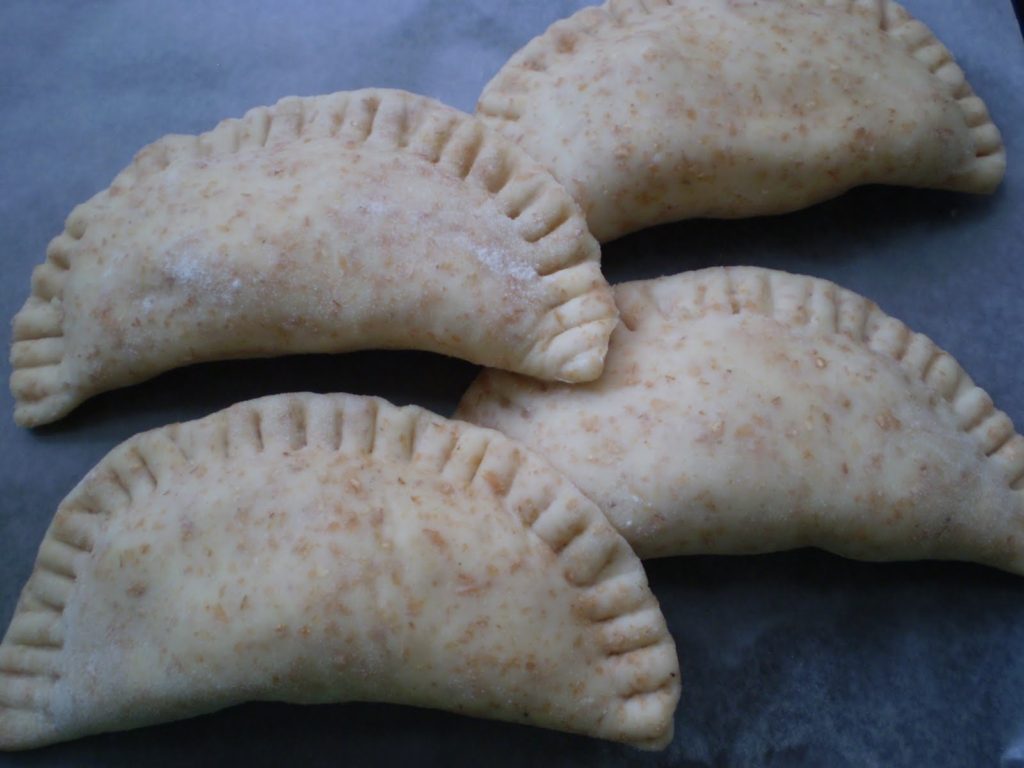This post was originally published on January 6 (Orthodox Christmas Eve!), 2013. Re-published today for those that took my session at Eat Alberta 2017. The only difference between what we did at Eat Alberta and the recipe below is that we used Sylvan Star medium gouda instead of orange Cheddar.
 There are as many recipes for perogies[1] as there are babas in the world. Some pillowy perogies have potato in the dough, as well as the filling.[2] Others are made with a simple dough of flour, sour cream, butter, and eggs. This is what I prefer…
There are as many recipes for perogies[1] as there are babas in the world. Some pillowy perogies have potato in the dough, as well as the filling.[2] Others are made with a simple dough of flour, sour cream, butter, and eggs. This is what I prefer…
This afternoon I made perogies, then ate four dozen of them, giving me ample opportunity to contemplate their mysteries.
The Dough. Full recipe is below. I whisk together the sour cream and eggs, then slowly add the melted butter while whisking. The flour goes into the bowl of a stand-mixer fitted with a paddle attachment. I slowly add the liquid mixture to the flower as the paddle attachment stirs on the lowest speed setting. As soon as a fairly smooth dough has formed we’re done mixing. I then wrap the dough in plastic wrap and let it rest at room temperature for at least two hours.
Cooking the Potatoes for the Filling. This is one of many recipes that requires cooking potato, milling or ricing it while it’s hot, then chilling thoroughly before further processing. You’ll notice that steam billows from the potato as it breaks up. This is good. We want to get some of the moisture out of the potato before we make the perogy filling.
I use a food mill, the kind that has a hopper with a screen on the bottom, and a slanted, rotary blade that pushes the potato flesh through that screen. There are also devices called ricers, that have pistons that push the potatoes through the screen. Both work well, provided the potatoes are cooked all the way through. If undercooked, the final dough won’t be perfectly smooth.
Once milled, I spread the potatoes out on a sheet tray and let them cool in the fridge.
The Filling. Apparently the traditional filling is cottage cheese, but in North America cheddar is king. The cheese is mixed with potatoes to give the perogies a structured filling. I mix finely grated cheddar with the milled potatoes in a stand mixer. The paddle kind of smears the cheese into the potatoes to make a homogeneous paste. I also add sour cream for moisture, acidity, and to help bind the filling. And salt. Even with all the cheese, this filling needs salt. The filling should be seasoned quite assertively so that it can be tasted through the dough.
The filling should be quite stiff when cold, otherwise it will run from the finished perogies when you cut into them, or worse, when you boil them.
Shaping. Once the dough is well rested, I roll it out to 1/8″ thickness. I use a 2.5″ ring cutter to punch circles out of the dough. (As a side note, I’ve seen some women shape their perogies without a cutter! They put a dollop of filling near the edge of the rolled dough, then lift and stretch the dough over the filling, and cut off the perogy from the sheet, leaving no trim!)
Once I have the circles cut, I put a bit of filling on each. I’m always surprised by how little cheese stuffing it takes to fill the perogies, maybe a tablespoon, about 10 grams by weight. Then simply fold the dough over the filling and pinch it off into the characteristic half-moon shape. If the dough is dry, a bit of water brushed on the surface will help it bind.
Perogy Trim. Using a round dough cutter will invariably create trim. This trim can be combined, and re-rolled. The re-rolled dough is a little harder to work with. Even after letting it rest, it will be tougher and springier than the original dough. It will resist rolling, and the perogies will not close up as easily. Perogies made from re-rolled dough will be slightly chewier, but it’s worth doing one re-roll, because about 20% of your original dough weight will be left behind as trim. I wouldn’t do more than one, as the dough becomes pretty much unworkable.
A friend told me that there are traditional Ukrainian dumplings made by reshaping and boiling perogy dough trim. He called them babaikas, (“ba-BYE-kahs”), but I can’t find any mention of them online or in my cookbooks. I made these from the trim from my re-roll.
Freezing and/or Cooking. At this point the raw perogies should be either frozen or boiled. They freeze beautifully. Just line a sheet pan with parchment and lightly dust with flour. Lay the perogies out on the tray and put it in the freezer. Once they’re frozen through, you can bag them. Using this method will keep the dumplings from sticking together.
To boil, fill a large pot with cold water. Season liberally and bring to a vigorous boil. The old adage is that when dumplings float in water, they’re done. Hervé This actually disproves this in his book Molecular Gastronomy, but it’s a bit of a “the bumblebee flies anyway” situation. After about two or three minutes in boiling water, fresh perogies will float, and they’re done. Frozen perogies obviously take longer to start bobbing.
Boiled v. Fried. Once boiled, consume immediately with onions, bacon, and sour cream. Once boiled, you can chill them and keep them the fridge for a few hours or days, just toss them in a small amount of oil to prevent them from sticking. Then simply pan-fry the cooked, chilled perogies to thoroughly brown and crisp the exteriors.
Here are the actual numbers I use.
Cheddar Perogies
The Dough
Master ratio – 5 parts flour : 2 parts sour cream : 1 part butter : 1 part eggs
- 1 kg flour
- 400 g sour cream
- 200 g unsalted butter, melted
- 200 g eggs
The Cheddar Filling
Master Ratio – 4 parts cold mashed potato : 2 parts finely grated cheese : 1 part sour cream, by weight. And a generous amount of salt.
Ingredients
- 400 g cooked, riced, chilled starchy potatoes
- 200 g finely grated cheddar, the orange kind
- 100 g, sour cream
- kosher salt to taste
Another extremely handy ratio is that you need about 10 g of filling to stuff 20 g of dough.
Footnotes
1. You’ve no doubt noticed that there are about one hundred different spellings of the word “perogy” in common usage. This is because many of the countries from which perogies come, places like Ukraine and Russia, use a different alphabet than us. Rendering the word “perogy” is often an issue of transliteration, not translation. If you hear a baba pronounce the actual Ukrainian word пиріг, they are clearly using sounds that don’t exist in English – how can they be transcribed? The Polish alphabet is much closer to our own. They spell it pierogi (that’s the plural form). I think the entire point is mute. It’s safe to say that perogies have been naturalized, and are part of Canadian prairie cuisine. I defer to the Ukrainian churches of Edmonton, who, when advertising dinners on signs, usually (but not always) use “perogy.”
2. If this style of perogy dough interests you, try this out for a dough recipe:
Ingredients
- 680 g all-purpose flour
- 420 g cooked, riced, chilled starchy potatoes
- 50 g unsalted butter. melted
- 50 g egg (one large egg…)
- 230 g sour cream
- 5 g kosher salt



